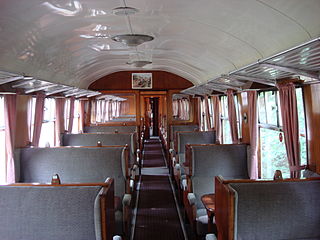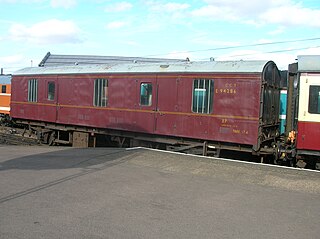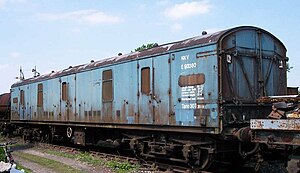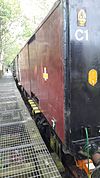
An autorack, also known as an auto carrier, is a specialized piece of railroad rolling stock used to transport automobiles and light trucks. Autoracks are used to transport new vehicles from factories to automotive distributors, and to transport passengers' vehicles in car shuttles and motorail services, such as Amtrak's Auto Train route.
British Railways coach designations were a series of letter-codes used to identify different types of coaches, both passenger carrying and non-passenger carrying stock (NPCS). The code was generally painted on the end of the coach but non-gangwayed stock had the code painted on the side. They have been superseded by TOPS design codes.

The Bideford Railway Heritage Centre CIC in Devon, England is a community interest company that is responsible for the management of the site of Bideford railway station. The company is also responsible for Instow signal box which opens on occasional Sundays and bank holidays from Easter to October.

British Rail was the brand image of the nationalised railway owner and operator in Great Britain, the British Railways Board, used from 1965 until its breakup and sell-off from 1993 onwards.

British Rail Mark 1 is the family designation for the first standardised designs of railway carriages built by British Railways (BR) from 1951 until 1974, now used only for charter services on the main lines or on preserved railways.

Rail Express Systems (RES) was a sector of British Rail. This sector was responsible for transport of mail and parcels, including the travelling post office trains, as well as taking over charter operations from InterCity and haulage of the Royal Train.

A Travelling Post Office (TPO) was a type of mail train used in Great Britain and Ireland where the post was sorted en route.

A propelling control vehicle (PCV) is a type of British railway carriage for carrying mail. They were converted from Class 307 driving trailers and have a cab at one end which allows slow-speed movement control. PCVs are unpowered but the controls allow mail trains to be reversed at low speed, using the power of the locomotive at the other end of the train. Similar BR Class 91 driving van trailer (DVT) used on the ECML differ by being fully equipped for high-speed train control.

Motorail was the brand name for British Rail's long-distance services that carried passengers and their cars. During its latter years of operation, it was grouped under the wider InterCity sector.

The British Rail Class 325 is an electric multiple unit (EMU) train owned by and operated for the Royal Mail to carry bulk mail. The class consists of four-car sets with dual-voltage 25 kV (AC) and 750 V (DC) power. While the Class 325 cabs bear a resemblance to the Networker family of DMUs and EMUs, the Class 325 is based on the Class 319.

Aberdeen railway station is the main railway station in Aberdeen, Scotland. It is the busiest railway station in Scotland north of the major cities of Glasgow and Edinburgh. It is located on Guild Street in the city centre, next to Union Square.

A mixed train or mixed consist is a train that contains both passenger and freight cars or wagons. Although common in the early days of railways, by the 20th century they were largely confined to branch lines with little traffic. Typically, service was slower, because mixed trains usually involved the shunting (switching) of rolling stock at stops along the way. However, some earlier passenger expresses, which also hauled time-sensitive freight in covered goods wagons (boxcars), would now be termed mixed trains. Generally, toward the end of the mixed train era, shunting at intermediate stops had significantly diminished. Most railway passenger and freight services are now administered separately.

A motorail train or accompanied car train (ACT) is a passenger train on which passengers can take their car or automobile along with them on their journey. Passengers are carried in normal passenger carriages or in sleeping carriages on longer journeys, while the cars are loaded into autoracks, car-carriers, or flatcars that normally form part of the same train.
The Sydney–Melbourne Express was an overnight intercapital passenger train service that operated between Australia's largest two cities, Sydney and Melbourne, between August 1986 and November 1993. Operated jointly by State Rail Authority and V/Line the name depended on the direction of travel, with the train nicknamed the 'Sex' or 'Mex'.

Railway Express Agency (aka REA Express) (REA), founded as the American Railway Express Agency and later renamed the American Railway Express Inc., was a national package delivery service that operated in the United States from 1918 to 1975. REA arranged transport and delivery via existing railroad infrastructure, much as today's UPS or DHL companies use roads and air transport. It was created through the forced consolidation of existing services into a national near-monopoly to ensure the rapid and safe movement of parcels, money, and goods during World War I.

The Diagram 960 PMVs were a series of Parcels and Miscellaneous Van (PMV), previously designated Passenger Luggage Van (PLV), built by the South Eastern and Chatham Railway (SE&CR) from 1919. The prototype van was used to carry the bodies of Edith Cavell, Charles Fryatt, and The Unknown Warrior from Dover to London, and has been preserved by the Kent and East Sussex Railway. The SE&CR vans were known as the Cavell Vans for this reason.

Covered Carriage Truck was a type of railway van with end doors used for moving motor cars or parcel traffic. Four wheeled CCT were banned from Motorail services in the mid-1960s. These vans were designed to be used for carrying motor cars in Motorail but the tight clearances inside the body of the van and closing/opening of the end doors took a lot of time and effort from staff. The vans were replaced by General Utility Vans (GUV) and car flats.

A car shuttle train, or (sometimes) car-carrying train, is a shuttle train used to transport accompanied cars (automobiles), and usually also bicycles and other types of road vehicles, for a relatively short distance.
The New South Wales stainless steel carriage stock was a type of passenger carriage operated by the New South Wales Government Railways from 1961 until 1993.



















